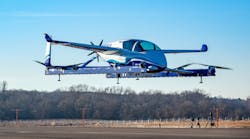If proponents of the rooftop urban air taxi concept have their way, in the not-so-distant future you'll be able to go to the top of a skyscraper and board a “flying car” for a short trip to another landing site either on the outskirts or on the other side of town. All the while, you avoid the ground traffic on the streets and highways below.
Boeing recently took a step toward that vision of the future when the company’s autonomous passenger air vehicle (PAV) prototype completed a controlled takeoff, hover, and landing during its first flight test in Manassas, Va.
Boeing’s PAV is an electric vertical takeoff and landing (eVTOL) aircraft that uses multiple horizontal propellers to provide vertical flight, while forward flight is accomplished by a single large rear propeller. Stubby wings allow the PAV to take advantage of lift, so that it doesn't have to rely exclusively on its propellers to stay aloft at speed. Its airframe integrates the propulsion and wing systems to achieve efficient hover and forward flight.
Designed by Boeing subsidiary Aurora Flight Sciences and under the auspices of Boeing NeXt, which is leading the company’s urban air mobility efforts, PAV measures 30 feet (9.14 meters) long and 28 feet (8.53 meters) wide. It’s designed for fully autonomous flight from takeoff to landing with a range of up to 50 miles (80.47 km).
Multiple propellers provide vertical flight, while forward flight is accomplished by a single “pusher” propeller. (Source: Boeing)
The test involved a controlled takeoff, hover, and landing and was designed to test the prototype’s autonomous functions and ground control systems.
Future flights will test forward, wing-borne flight, as well as the transition phase between vertical and forward flight, typically the most strenuous technical challenge for high-speed VTOL aircraft.
The PAV isn’t the only air mobility project at Boeing NeXt. The company is also developing a crewless, all-electric cargo air vehicle (CAV), which is designed to transport up to 500 pounds up to 20 miles. The CAV completed its first indoor flight last year and will transition to outdoor flight testing later this year.
Boeing NeXt works with regulatory agencies and industry partners to pave the way for responsible introduction of new mobility ecosystems and ensure a future where autonomous and piloted air vehicles safely coexist.
Urban Air Mobility Contest
To support accessible air-transport systems for passengers and cargo by working with the urban air mobility (UAM) community, NASA and the Federal Aviation Administration (FAA) have set up a program called the Urban Air Mobility Grand Challenges. They’re modeled in part on the DARPA Grand Challenges competition for autonomous land vehicles of more than a decade ago.
By way of review, the DARPA contests offered million-dollar prizes for self-driving cars that could negotiate the twists and turns of streets and highways. Similarly, the UAM Grand Challenges will test how well new types of air vehicles and new software platforms for air traffic management perform in urban environments. But this time, there will not be prizes to be won.
In 2020, NASA will host a UAM ecosystem-wide challenge for participants to execute system-level safety and integration scenarios within a robust, relevant environment. The goal of this first in a series of UAM Grand Challenges, which NASA is calling GC-1, is to promote public confidence in UAM safety and facilitate community-wide learning while capturing the public’s imagination.


